
Single intrastromal corneal implant favored for paracentral/peripheral cones
Placement of a single intrastromal corneal implant (Intacs, Addition Technology) appears to offer better results than double-segment placement when treating keratoconus in eyes with paracentral/peripheral cones, said Colin C. Chan, MD.
Placement of a single intrastromal corneal implant (Intacs, Addition Technology) appears to offer better results than double-segment placement when treating keratoconus in eyes with paracentral/peripheral cones, said Colin C. Chan, MD.
Dr. Chan presented the results from a retrospective study comparing the two techniques. It was conducted at the Boxer Wachler Vision Institute, Beverly Hills, CA, in conjunction with Dr. Chan's co-author, Brian S. Boxer Wachler, MD.
The study included 20 eyes of 17 patients that underwent double-segment placement and 17 eyes of 11 patients that had a single segment placed. Most of the single-segment procedures were done with the 0.25-mm insert and for the double-segment technique, the most common combination used was a 0.25-mm segment above and a 0.35-mm segment below. All patients had peripheral cones and all of the surgeries were done with the axis of incision in the meridian of the steepest axis. The two study groups were also matched preoperatively.
The results showed significantly better outcomes in the single-segment group for all comparisons of change in cylinder, keratometry values, uncorrected visual acuity, and best-corrected visual acuity (BCVA). Overall, the eyes that had two corneal implants placed achieved an average of 1 line improvement in BCVA compared with a 2 to 3 line gain in the single-segment group.
"It is pretty well accepted that Intacs have a role in the management of keratoconus, but there remains heated debate about whether a single- or double-segment approach should be used," Dr. Chan said. "Our results support a single-segment approach in eyes with paracentral/peripheral cones, and we think there are two reasons to explain its benefits.
"First, keratoconus is a disease of corneal asymmetry with a steep area below and a flat area above, and so in using the segments to flatten the cornea," Dr. Chan said. "It seems to make sense to just place a single-segment below. In addition, segment placement appears to have a corneal coupling effect that is analogous to sitting on a beanbag - 'sitting' on one end causes the other to pop up."
Newsletter
Don’t miss out—get Ophthalmology Times updates on the latest clinical advancements and expert interviews, straight to your inbox.


















































.png)


